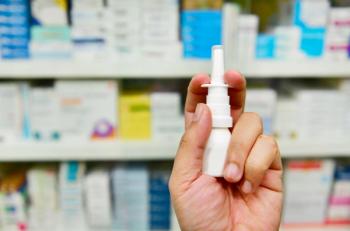
FDA Approves Sibeprenlimab for Immunoglobulin A Nephropathy
Key Takeaways
- Sibeprenlimab is approved for IgAN treatment, showing a 51.2% reduction in proteinuria in the VISIONARY trial.
- Administered subcutaneously every four weeks, it inhibits APRIL to reduce IgA levels.
Sibeprenlimab gains accelerated approval from the FDA for IgA nephropathy, showing significant proteinuria reduction and offering convenient self-injection treatment.
The FDA has approved sibeprenlimab-szsi (Voyxact; Otsuka) to reduce proteinuria in adults who have
Also known as Berger disease, IgAN manifests after IgA builds up to excessive levels in the kidneys, impeding blood filtration; it is typically progressive, with patients’ outcomes including leaking blood into urine, loss of kidney function, and kidney failure.2 There is no cure.
"Voyxact is the first approved treatment for adults with primary IgAN at risk for disease progression that blocks the activity of APRIL," said Dana Rizk, MD, professor of medicine, Division of Nephrology, University of Alabama at Birmingham; VISIONARY study investigator; and cochair of the steering committee,
Data used to support this approval show a 9-month proteinuria reduction of 50% vs 2% in those who received placebo1; the placebo-adjusted treatment effect was 51% (P < .0001).3 In VISIONARY, the entire study cohort (N = 510) is receiving standard-of-care treatment of a maximally tolerated angiotensin-converting enzyme inhibitor and/or an angiotensin receptor blocker with or without a sodium-glucose cotransporter 2 inhibitor, "designed to evaluate the efficacy and safety of sibeprenlimab 400 mg administered subcutaneously every 4 weeks, compared to placebo."
A prespecified interim analysis of VISIONARY data was presented at the European Renal Association Congress in Vienna, Austria, in June, showing a 51.2% reduction (P < .0001) in proteinuria per 24-hour urine protein-to-creatinine ratio by 9 months of treatment vs placebo.4 Safety data also were positive, showing 76.3% of treated patients compared with 84.5% of patients who received placebo experienced any treatment-emergent adverse event (AE), with serious AE rates of 3.9% and 5.4%, respectively.
All patients enrolled in VISIONARY have biopsy-confirmed IgAN, and the primary efficacy end point is 24-hour change in urine protein-to-creatinine ratio at 9 months vs baseline in the first 320 patients to reach their 9-month visit.1,3 To be included in the trial, patients had to have biopsy-confirmed IgAN, a urine protein-to-creatinine ratio of at least 0.75 g/g or urine protein of at least 1.0 g/day, and an estimated glomerular filtration (eGFR) rate of 30 mL/min/1.73 m2 or higher, and be on a stable dose of supportive therapy.3
Common adverse reactions in VISIONARY were infections and injection site reactions seen in higher numbers of treated patients vs those who received placebo, at 49% vs 45% and 24% vs 23%, respectively.
Sibeprenlimab previously received a priority review designation from the FDA in May based on data from VISIONARY and the phase 2 ENVISION trial (
This monoclonal antibody also received a breakthrough therapy designation from the FDA in February 2024 based on ENVISION data.7 In this multicenter, double-blind, placebo-controlled, parallel-group trial, patients with biopsy-confirmed IgAN were randomized in a 1:1:1:1 ratio to receive intravenous 2-mg (n = 38), 4-mg (n = 41), or 8-mg (n = 38) sibeprenlimab per kilogram of body weight or placebo (n = 38) once monthly for 1 year.8 The primary and secondary end points, both measured from baseline, were change in 24-hour urine protein-to-creatinine ratio at month 12 and change in eGFR, respectively. The greatest mean (SE) reduction in protein-to-creatinine ratio was 62.0% (5.7%) seen in those who received the 8-mg dose, followed by 58.8% (6.1%) from the 4-mg dose and 47.2% (8.2%) from the 2-mg dose; the placebo group came in at 20.0% (12.6%). Corresponding eGFR least-squares mean changes were −1.5 (1.8), 0.2 (1.7), −2.7 (1.8), and −7.4 (1.8) mL/min/1.73 m2.
A confirmatory trial is still needed to determine if sibeprenlimab can slow kidney function decline over the long term (ie, at 24 months), as well as for ongoing approval of this new indication. Updated eGFR data are expected in early 2026, and will be used to support full FDA approval.
References
- FDA approves a new treatment for primary immunoglobulin A nephropathy. FDA. News release. November 25, 2025. Accessed November 26, 2025.
https://www.fda.gov/drugs/news-events-human-drugs/fda-approves-new-treatment-primary-immunoglobulin-nephropathy - IgA nephropathy (Berger disease). Mayo Clinic. Accessed October 2, 2025.
https://www.mayoclinic.org/diseases-conditions/iga-nephropathy/symptoms-causes/syc-20352268 - Otsuka received FDA accelerated approval for Voyxact (sibeprenlimab-szsi) for the reduction of proteinuria in adults with primary immunoglobulin A nephropathy (IgAN) at risk for disease progression. FDA. News release. November 25, 2025. Accessed November 26, 2025.
https://otsuka-us.com/news/otsuka-receives-fda-accelerated-approval-voyxactr-sibeprenlimab-szsi-reduction-proteinuria - Otsuka sibeprenlimab phase 3 data show a statistically significant and clinically meaningful proteinuria reduction for the treatment of immunoglobulin A nephropathy (IgAN). News release. Otsuka. June 6, 2025. Accessed October 2, 2025.
https://www.otsuka-us.com/news/otsuka-sibeprenlimab-phase-3-data-show-statistically-significant-and-clinically-meaningful - Myshko D. FDA grants priority review to sibeprenlimab for the kidney disease IgAN. Managed Healthcare Executive®. May 27, 2025. Accessed October 2, 2025.
https://www.managedhealthcareexecutive.com/view/fda-grants-priority-review-to-sibeprenlimab-for-the-kidney-disease-igan - Otsuka announces FDA acceptance and priority review of biologics license application (BLA) for sibeprenlimab in the treatment of immunoglobulin A nephropathy. News release. Otsuka. May 27, 2025. Accessed October 2, 2025.
https://www.otsuka-us.com/news/otsuka-announces-fda-acceptance-and-priority-review-biologics-license-application-bla - Sibeprenlimab received U.S. FDA breakthrough therapy designation for the treatment of immunoglobulin A nephropathy (IgAN). News release. Otsuka. February 16, 2024. Accessed October 2, 2025.
https://www.otsuka.co.jp/en/company/newsreleases/2024/20240216_1.html - Mathur M, Barratt J, Chacko B, et al. A phase 2 trial of sibeprenlimab in patients with IgA nephropathy. N Engl J Med. 2024;390(1):20-31. doi:10.1056/NEJMoa2305635
Newsletter
Stay ahead of policy, cost, and value—subscribe to AJMC for expert insights at the intersection of clinical care and health economics.









































